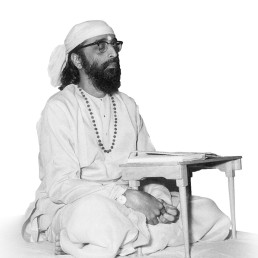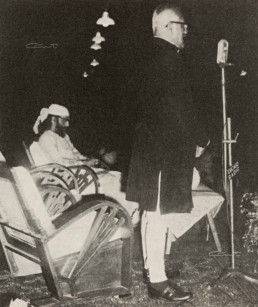
Jnana Yajna 101

Year & Dates:
March 05, 1962 to March 26, 1962

Yajna Topic:
Shrimad Bhagavad Gita- Chapter 18

Place:
New Delhi, India
As if deaf to the praise and applause for His Centenary Jnana Yajna, Pujya Gurudev went into meditative Silence on the auspicious Mahasivarathri day of March 4 during the spiritual retreat at Kakular near Chennai. Then, He boarded the Calcutta Mail to Vishakapatanam and talked about Life before He boarded the flight to Delhi to reach there for His 101st yajna.
Ever on the move, always in the vital present, He looked up at another Om flag going up to signal another yajna on the evening of March 10, 1962 at New Delhi.
The yajnashala was constructed tastefully in an area of around 27,000 square feet with 12,000 sq. feet under a bright shamania. Located centrally on Parliament Street close to Connaught Place, it attracted huge, enthusiastic crowds – for the faithful followers in Delhi, it was a much-anticipated jnana yajna, and the excitement was palpable.
Sanctifying Study, Surrender, and Action
The Chief Justice of India, Sri B.P. Sinha, presiding over the inaugural ceremony of the yajna expressed the collective gratitude of Delhi for Pujya Gurudev’s monumental efforts and said: “The Gita, apart from a being a religious scripture of the Hindus, embodies the philosophy of universal truth that a thing well-done is its own reward, and the ordinary human being can do no better than discharge their own assigned duties to the best of their abilities.” He pointed out to the message of Gita echoed in Longfellow’s poetic lines:
“…Act, Act in the Living Present!
Heart within, and God o’er Head!”
Pujya Gurudev had chosen to teach chapter 18, the summative finale of Srimad Bhagavad Gita, during His evening discourses from 6:15 pm to 7:45 pm. For more intensive study in the mornings from March 12th, from 8 am to 9:15 am, He decided to enlighten the serious seekers on the sublimity of Sri Vidyaranya’s Panchadasi chapter 10, the Natakadipa Prakarana.
A special souvenir was released to mark the occasion and donate the funds raised from the advertisements to the Tara Cultural Trust overseeing the upcoming Sandeepany Sadhanalaya. In that souvenir, a chief patron of the 101st yajna, Sri. Rajendra Prasad, the President of India wrote: “I send my good wishes to Sri Chinmaya Gita Jnana Yajna with whose activities I am somewhat familiar. I wish success to this organization which aims at making people conscious of spiritual, moral, and religious values in life.”
Pujya Gurudev, with His scintillating exposition on Moksha Sannyasa Yoga of chapter 18, made clear the difference between sannyasa and tyaga. Echoing the Upadesha (advice) that Bhagavan Krishna gave to Arjuna, the surrendered seeker, He emphasized how to divinize various aspects such as Shraddha (faith), dana (charity), dhriti (fortitude) and more while clarifying about the aspects and type of duties to never forsake. He also exhaustively described the play of the gunas in life, holding a mirror to our delusions in life.
Pujya Gurudev carried seekers of all backgrounds and nationalities in Delhi to the heights of Vedanta, both through the Gita and Panchadasi guiding all to “know” Who is the Supreme Illuminator and what to do with whatever is given in life. The audience were left recalling again and again the indescribable glory of His words and Presence throughout the 101st Jnana Yajna.
A Meditation Minute:
स्वयं कुर्वन् कारयंश्च कर्माणि विविधानि यः । असक्तः सर्वकार्येषु वर्तते सर्वदा च सः ॥४॥
svayaṃ kurvan kārayaṃśca karmāṇi vividhāni yaḥ । asaktaḥ sarvakāryeṣu vartate sarvadā ca saḥ ॥4॥
- Himself doing and inspiring others to do various projects, he ever remains unattached in all of them.
We are deeply inspired by Pujya Gurudev’s supreme efficiency and dispassionate, detached excellence in His every action. A fascinating, inspiring conductor of the symphony of increasing activities and spreading centers of Chinmaya Mission, He truly personifies the beauty of doing without desire, independent of results, ever established in the Highest.
Photo Gallery

“Think,” Says Pujya Gurudev
In a Yajna, Lord Fire is involved in the sacrificial altar, and into it are offered oblations by the devotees. From this analogy the term Jnana Yajna has been originally coined and used in the Geeta. Study of the Scriptures and regular contemplation upon their deep significance kindle the “Fire of knowledge” in us and into this the intelligent seeker offers, as his oblation, his own false values and negative tendencies. This is the significance of the metaphorical phrase Jnana Yajna. The Lord, therefore, admits but a truth in the Spiritual Science when He declares that those who study the Geeta-contemplate upon its meaning, understand it thoroughly and those who can, at the altars of their well kindled understanding, sacrifice their own egocentric misconceptions about themselves and the world around them are, certainly the greatest devotee of the Infinite.
From Tyagi Magazine
Do not Compromise!
The essence of the video lies in living life with conviction and purpose, regardless of circumstances, even in the face of death or adversity. By adhering to one’s beliefs and principles, individuals can find joy and fulfillment, contributing positively to society and leaving a lasting impact, as exemplified by historical figures like Christ and the transformative power of personal conviction.




